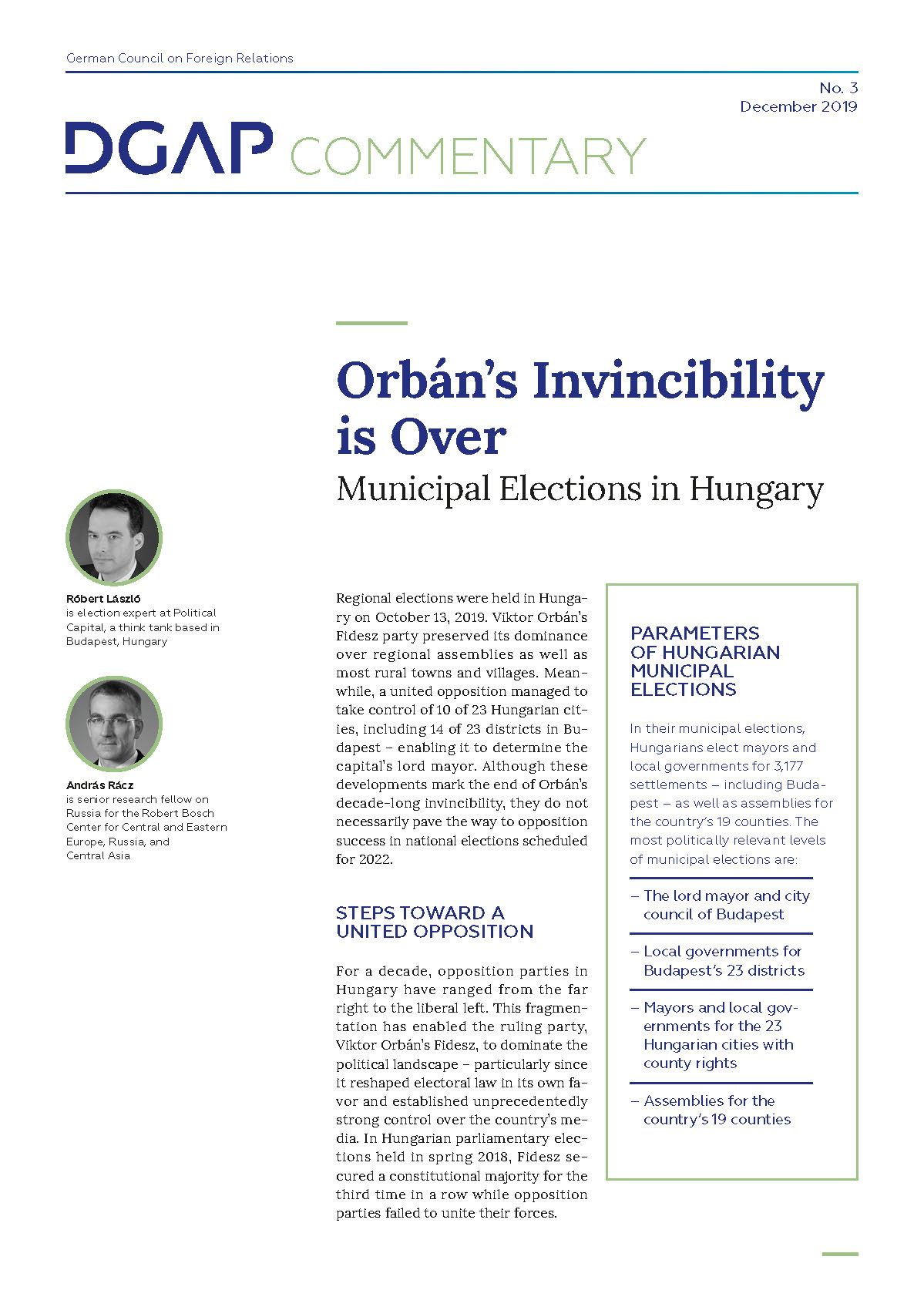Steps Toward a United Opposition
For a decade, opposition parties in Hungary have ranged from the far right to the liberal left. This fragmentation has enabled the ruling party, Viktor Orbán’s Fidesz, to dominate the political landscape – particularly since it reshaped electoral law in its own favor and established unprecedentedly strong control over the country’s media. In Hungarian parliamentary elections held in spring 2018, Fidesz secured a constitutional majority for the third time in a row while opposition parties failed to unite their forces.
This devastating 2018 defeat, however, turned out to be a catalyst for opposition forces to change their strategy. Since early 2019, negotiations were held to nominate joint candidates for the local elections in October. European Parliamentary elections held in May 2019 provided additional impetus for reshuffling the opposition. Their results convinced all parties of the necessity to cooperate – even those that had previously ruled it out.
By the municipal elections of October 2019, opposition parties had managed to nominate single, jointly-supported mayoral candidates in almost all 46 of Hungary’s larger districts and cities – along with further such candidates in a handful of smaller settlements.
- Parameters of Hungarian Municipal Elections
-
In their municipal elections, Hungarians elect mayors and local governments for 3,177 settlements – including Budapest – as well as assemblies for the country’s 19 counties. The most politically relevant levels of municipal elections are:
- The lord mayor and city council of Budapest
- Local governments for Budapest’s 23 districts
- Mayors and local governments for the 23 Hungarian cities with county rights
- Assemblies for the
- country’s 19 counties
The Election Results
On the basis of data, both Fidesz and the opposition have plenty of grounds to claim victories in October 2019’s municipal elections. On the one hand, opposition gains in certain settlements constitute a considerable breakthrough, especially compared to very moderate expectations. On the other, Fidesz gained many more votes than it had received in the municipal elections of 2014. In order to understand these seemingly contradictory results, detailed examination is needed.
By cooperating more effectively in the October 2019 elections than they ever had, opposition forces managed to secure more mayoral seats. In almost all of Budapest’s 23 districts and Hungary’s 23 biggest towns, opposition forces fielded a joint mayoral candidate. In comparison, in most places in 2014’s elections, several opposition candidates competed for each seat, resulting in vote fragmentation that benefitted Fidesz.
Since 2006, the opposition had not fielded a candidate for lord mayor of Budapest, whom voters believed to be capable of defeating an opponent affiliated with Fidesz. The fact that such a lord mayoral candidate was fielded in 2019 was not only a boost for opposition campaigns in all of Budapest’s districts, but it also had a nationwide effect as well. Although many – mainly in larger towns – viewed the municipal elections as an anti-Orbán referendum, the opposition also managed to reach out to those voters who cast their ballots for candidates offering answers to local issues.
The opposition understood that – due to Fidesz’ dominance of the media and the opposition’s lack of access to public advertising space – it only had two remaining channels to reach its voters: social media and, more importantly, face-to-face campaigns. Hence, opposition parties concentrated their efforts on these two fields. Local campaign teams, who were recruited from different opposition parties, worked with remarkable efficiency. When comparing October 2019’s regional elections to those of 2014, the opposition mobilized more new voters than Fidesz.
Last but not least, the sex and corruption scandal surrounding Zsolt Borkai, mayor of the northwestern city of Győr, certainly encouraged turn out among anti-Orbán voters, although the exact effect of the scandal cannot be quantified.
Together, all of these factors led to the transformation of the political landscape described in Figure 1.
Figure 1: The political landscape after the 2019 municipal election in Hungary
Fidesz Did Not Become Weaker
Nevertheless, Fidesz’s performance was impressive, especially when compared to previous elections. The party still does not seem to have a challenger in smaller settlements, and it even managed to gain new voters in larger cities and the capital.
The aggregated share of votes received by Fidesz on county lists improved to 57.2 percent in 2019 from 52.6 percent in 2014. Considering how dominant the party already was in 2014, this is a massive improvement. It must be noted that voters living in the capital and the 23 cities with county rights do not vote for these county lists Thus, these data illustrate the power of Fidesz in smaller settlements – which, however, still cover the larger part of Hungary.
Contrary to popular belief, it is not true that Fidesz is only strong in small rural settlements. In fact, over a third of the party’s voters live in the capital and larger cities. In the parliamentary elections of 2018, opposition candidates triumphed in two-thirds of Budapest’s single-member-constituencies; moreover, they could have won 100 percent had they fielded a joint candidate in all of them. But this success for the opposition did not stop Fidesz from gaining a two-thirds majority in parliament in 2018. Had there also been a municipal election that year, Fidesz likely would have lost most Budapest districts. Nevertheless, in October 2019 – only one and a half years later – Fidesz won 9 of 23 of Budapest’s districts, which can well be interpreted as a solid improvement. Moreover, there were mayoral candidates fielded by Fidesz in several larger cities who gained significantly more votes in October 2019 than they did in the previous local elections. This time, they only failed to win because of the more effective cooperation between oppositional parties.
While the fact that the opposition won 10 cities out of the largest 23 is impressive at first glance, it also indicates that a joint candidate per se is not enough for a complete victory. If we consider that, in 2018’s general election, opposition candidates gained more votes than Fidesz candidates in 21 out of these 23 cities, the opposition’s achievements in 2019’s municipal elections no longer seem that remarkable. These data indicate that voter decisions are not only influenced by party sympathies, but also by whether people believe in the effectiveness of both mayoral and parliamentary candidates on a local level – and whether people believe that opposition candidates can actually beat competitors affiliated with Fidesz.
The Way Forward
The local elections held on October 13, 2019 marked the end of a decade in which Viktor Orbán’s party could win all national, regional, and European Parliamentary elections. Though the ruling party managed to preserve control over the countryside, the loss of Budapest and ten major cities is undoubtedly a serious blow.
Though the election results can be interpreted in different ways – both the opposition and Fidesz can claim themselves as winners – one thing has certainly changed: the myth of Fidesz’s invincibility is broken. Both pro- and anti-Orbán voters can see clear chances for Fidesz’s defeat, even at the parliamentary level. This psychological and symbolic effects of this shift cannot be overestimated.
The myth of Fidesz’s invincibility is broken
However, it is still too early to draw any far-reaching conclusions for the next parliamentary election, which is scheduled for spring 2022. The opposition’s cooperation strategy for this election is not yet ready – particularly because Hungary has a mixed election system, composed of both single-member constituencies and party lists. One thing, however, is already certain: the opposition needs to field a single candidate to challenge Fidesz in all 106 single-member constituencies. Whether the opposition should field a joint party list or run separately is still up for debate. Besides, opposition parties are still very far from finding a leader who could challenge Viktor Orbán as a candidate for prime minister.
Moreover, over the next two and a half years, the opposition parties will face increasing pressure from both the ruling party and their own corruption-related temptations, challenging them to maintain their coherence. Initial signs of fragmentation are already visible as a result of the Socialist Party bringing some doubtful figures of the 2000s back into local government positions.
It also remains to be seen, how the ruling party will treat cities led by the opposition. The Orbán government may well opt to use solid, demonstrative financial pressure against opposition-led cities – not only depriving them of resources from the central budget, but also making it hard for them to access EU funds. Making opposition-led cities fail or underperform is a strategy that could aim to demotivate and deter potential opposition voters by showing them the negative effects of moving against the ruling party. Meanwhile, the election of Gergely Karácsony as lord mayor of Budapest paves the way for closer cooperation among the four Visegrad capitals; Warsaw, Prague, Bratislava, and Budapest are now all led by liberal mayors. Perhaps they will bypass their national governments to jointly lobby for receiving EU funds directly.
Against this background – and because Budapest and the major cities under opposition control have a combined population of approximately three million – it is highly likely that the upcoming years will see increasing polarization and near-permanent campaigning in Hungarian domestic politics.



